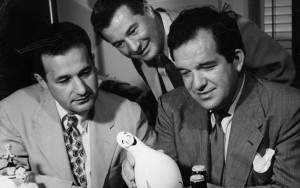
Al Capp (right) cradles a shmoo doll as he shows his brothers Elliot (left) and Jerry “Bence” some of the mountain of merchandise from his comic strip “Li’l Abner” in 1950. Credit: Journal Sentinel files
Article by Chris Foran of the Journal Sentinel:
It’s hard to overstate how big a deal in pop culture “Li’l Abner” was in its day.
At its peak, the comic strip by Al Capp was published in more than 900 newspapers in North America, with more than 70 million readers. The strip sparked merchandising juggernauts, TV shows, movies, a Tony-winning Broadway musical and even a theme park.
It also made Capp a cultural figure in his own right — at least until his personal behavior led to a downfall.
As Michael Schumacher and Denis Kitchen relate in their terrific biography “Al Capp: A Life to the Contrary,” Capp was working as an assistant on the comic strip “Joe Palooka” in 1933 when he introduced a backwoods brawler named Big Leviticus — a character who became the basis for some of his creations in “Li’l Abner.”
Set in the rural enclave of Dogpatch, Ky., “Li’l Abner” centered on the world swirling around the title character, an oafish, clueless soul with big ideas and a bigger physique.
Capp used Dogpatch as a cornpone canvas, first as broad satire but eventually as creative commentary on the American scene, lampooning everything from rival comic strips to pop stars.
In addition to Li’l Abner, there was his persistent suitor, Daisy Mae (think Daisy Duke before there was a Daisy Duke); Mammy and Pappy Yokum, Abner’s parents; and a slew of supporting characters, including Joe Btfsplk, a jinxed guy with a black cloud over his head, and Sadie Hawkins, a girl so homely her father staged a footrace in which the unmarried women of Dogpatch pursued the hamlet’s bachelors. (The high school dance in which girls ask the guys was inspired by Capp’s creation.)
The strip began in six newspapers on Aug. 13, 1934. The Journal jumped in early, adding it to the Green Sheet in Sept. 10 of that year.
“Li’l Abner” quickly became a cultural obsession. One character — the “shmoo,” a white blob with a cuddly disposition that could provide all sorts of foodstuffs with ease — was so popular that merchandise in its first year generated more than $25 million in sales (about $245 million in 2016 dollars).